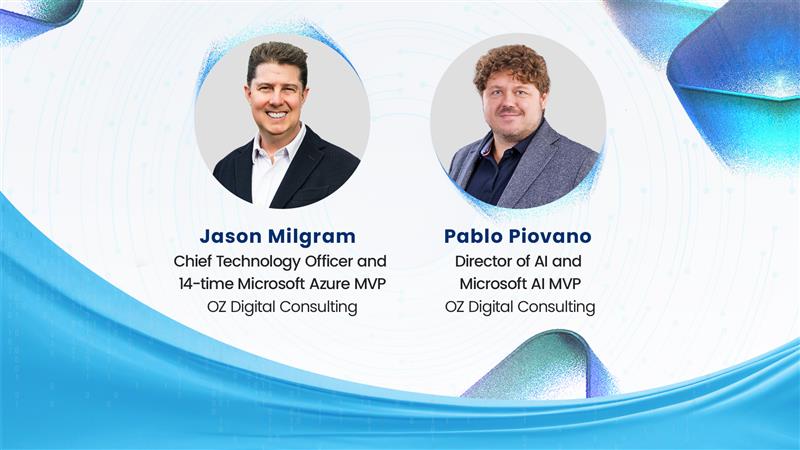By Jason Milgram, Senior Vice President, Azure Leader
There’s been a lot of buzz around Microsoft Fabric since its launch last year. Over 25000 customers are using Fabric today, including 67% of Fortune 500 companies. Microsoft Chairman and CEO Satya Nadella even declared Fabric the company’s most significant data product since SQL Server. [Watch the full Satya Nadella keynote here]
If you haven’t caught up yet on Microsoft Fabric, now’s the time:
Microsoft Fabric is an AI-powered analytics and data management platform that brings together the capabilities of Power BI, Data Factory, and Azure Synapse Analytics. Its popularity with the data community isn’t only because it unifies three formerly separate platforms. Its success has more to do with all the data store options it provides. By creating a whole new environment for data integration, data management, and analytics, Fabric will change the way you think about architecture, scalability, and value.
I’ve worked with many data management platforms, but here’s why I would choose Microsoft Fabric — and you should, too.
Microsoft Fabric Lakehouse: The Best of Data Lakes and Data Warehouses
First, there was the data warehouse, a data storage architecture that allowed structured data to be archived for specific business purposes. Then came Big Data. As unstructured data began to increase, a different type of architecture known as the data lake emerged — where unstructured information is stored in its raw, native format. The downside of a data lake is that, while it offers flexibility, it can easily become a data swamp without proper governance.
A platform like Microsoft Fabric provides you with an entirely new way to store your data, bringing the best of both worlds — from the data warehouse and data lake models — into one “data lakehouse.”
So, what is a data lakehouse? It’s a hybrid architecture that lets you store all your data in a data lake and run AI and BI on that data directly — at scale. It has the SQL and performance capabilities (indexing, caching, MPP processing) to make BI work fast on data lakes. It also has direct file access and direct native support for Python, data science, and AI frameworks without ever forcing it through a SQL-based data warehouse.
What That Means for You
Provisioning a data lakehouse in Microsoft Fabric means you only need one data repository instead of both warehouse and lake infrastructure. With a data lakehouse, you can streamline your overall data management process and break down data silos — all in one unified platform.
This integration creates a more efficient end-to-end process with several benefits:
- Better data governance: Data lakehouses improve governance by consolidating data sources. A standardized open schema allows greater control over security, metrics, role-based access, and management.
- Simplified standards: Localized schema standards were often created within organizations using data warehouses. Today, open schema standards exist for many types of data, and data lakehouses make the most of them by ingesting multiple data sources with an overlapping standardized schema to simplify processes.
- Cost-effectiveness: The data lakehouse infrastructure separates compute and storage, which makes it easy to add storage without having to add compute power.
Key Advantages:
Combining data lakes and data warehouses into data lakehouses allows your data teams to work quickly as they don’t have to access multiple systems for the data. That’s not all. There’s a slew of other advantages like:
- Real-time data processing:Process streaming data in real-time for immediate analysis and action.
- Data integration:Unify your data in a single system to enable collaboration and a single source of truth for your organization.
- Schema evolution:Modify data schema with time without disrupting existing data pipelines.
- Data transformation: Bring speed, scalability, and reliability to your data with Apache Spark and Delta Lake.
- Data analysis and reporting:Run complex analytical queries with an engine optimized for data warehousing workloads.
- Machine learning and AI:Apply advanced analytics techniques to all of your data, while using ML to enrich your data and support other workloads.
- Data versioning and lineage:Maintain version history for datasets and track lineage to ensure data provenance and traceability.
- Data governance:Use a single, unified system to control access to your data and perform audits.
- Data sharing:Enables collaboration by sharing curated data sets, reports, and insights across teams.
- Operational analytics:Monitor data quality metrics, model quality metrics, and drift by applying machine learning to lakehouse monitoring data.
- No code low code architecture: Facilitates the creation of a lakehouse with just a few clicks, without the need for extensive coding.
- Streamlined data ingestion:Offers many ways to ingest data into the lakehouse. Whether building from the ground up or having existing data pipelines, the platform provides intuitive tools for better data ingestion.
- Data landing and storage flexibility:The platform provides flexibility in how data lands in the lakehouse. You can land data as a file copy, retaining its original format with a simple upload or drag and drop, or allow the platform to structure the data in a Delta format using tables.
- Shortcuts:One of the standout features is shortcuts, which allow users to reference data internally within Fabric via Onelake and externally, such as in ADLs Gen 2 or Amazon S3. This means that data doesn’t need to be copied over; instead, a reference link is created, avoiding data duplication.
Data Storage at Scale
With multi-cloud capabilities, the lakehouse architecture improves collaboration and streamlines data management, while providing uniform security across the organization. Get more value from your data with these key features:
- Data Referencing:Instead of copying data, the Lakehouse architecture promotes referencing, ensuring the data remains in its original location (e.g., ADLs account) while still being accessible for analysis in the Lakehouse. An approach that optimizes performance and reduces redundancy.
- Optimizing data management for speed and efficiency:The architecture ensures that while data feels integrated within the Lakehouse for analysis and management purposes, it’s efficiently referenced, ensuring optimal performance and scalability.
Partner with the Experts
The Microsoft Fabric Lakehouse offers unparalleled advantages, giving you the tools and frameworks you need to handle and analyze large volumes of data. With over 25 years of technology experience, OZ can guide and help you scale your data storage with Microsoft Fabric. Contact us today and get started.



